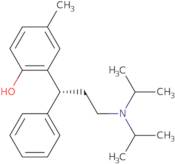R-(+)-Tolterodine
CAS: 124937-51-5
Ref. 3D-FT28311
| 2mg | Ausgelaufen | ||
| 5mg | Ausgelaufen | ||
| 10mg | Ausgelaufen | ||
| 25mg | Ausgelaufen | ||
| 50mg | Ausgelaufen |
Produktinformation
- 2-[(1R)-3-[Bis(1-methylethyl)amino]-1-phenylpropyl]-4-methyl-phenol(R)-(+)-N,N-Diisopropyl-3-(2-hydroxy-5-methylphenyl)-3-phenylpro pylamine(R)-Tolterodine
- 124937-51-5
- 2-[3-(dipropan-2-ylamino)-1-phenylpropyl]-4-methylphenol
- 2-[(1R)-3-(dipropan-2-ylamino)-1-phenylpropyl]-4-methylphenol 2,3-dihydroxybutanedioate (1:1)
- phenol, 2-[3-[bis(1-methylethyl)amino]-1-phenylpropyl]-4-methyl-
- 2-{3-[bis(1-methylethyl)amino]-1-phenylpropyl}-4-methylphenol
- 2-[(1S)-3-(dipropan-2-ylamino)-1-phenylpropyl]-4-methylphenol
- 2-[3-(diisopropylamino)-1-phenyl-propyl]-4-methyl-phenol hydrochloride
Tolterodine is a drug that acts as a selective antagonist at the muscarinic receptor M3. It is used in the treatment of overactive bladder and other patients with bowel disease. Tolterodine has been shown to be effective in both animal models and humans for the treatment of overactive bladder. The mechanism of action of tolterodine is not fully understood, but it may involve blockade of postsynaptic M3 receptors in the bladder, leading to relaxation of smooth muscle and decreased contractility. Tolterodine is metabolized by various enzymes, including CYP2D6 and CYP3A4, which are primarily found in the liver and gut respectively. To date, there have been no reports of drug interactions between tolterodine and other drugs metabolized by these enzymes.





